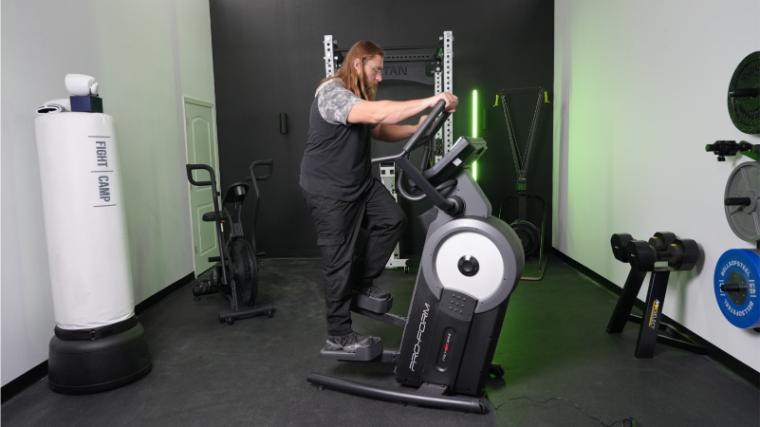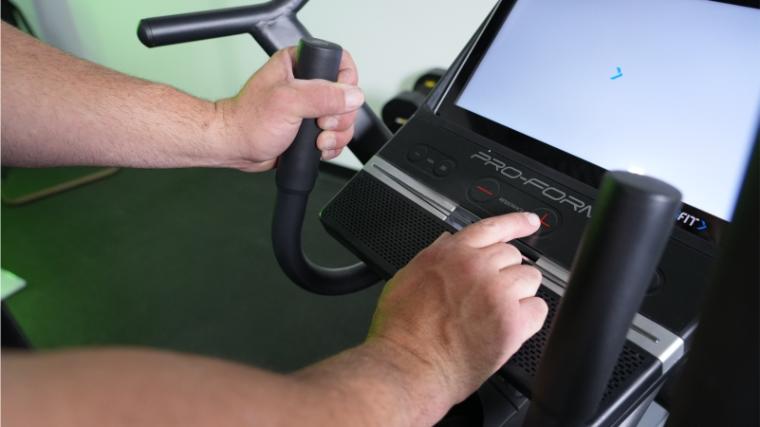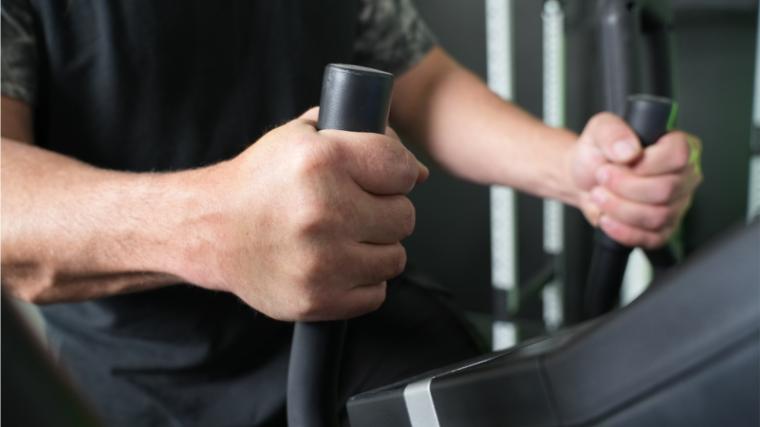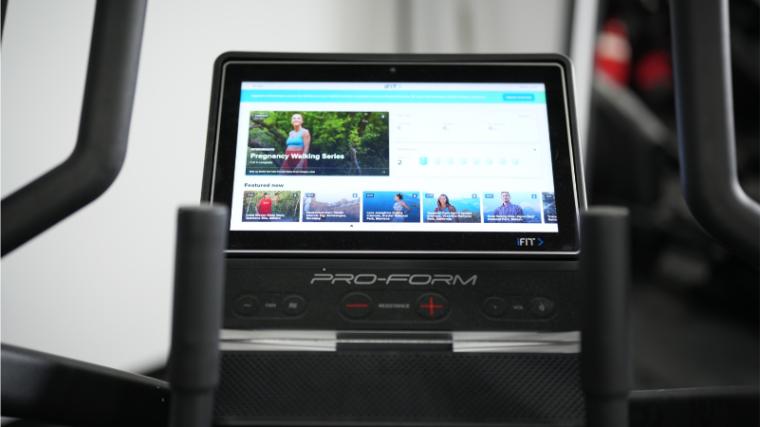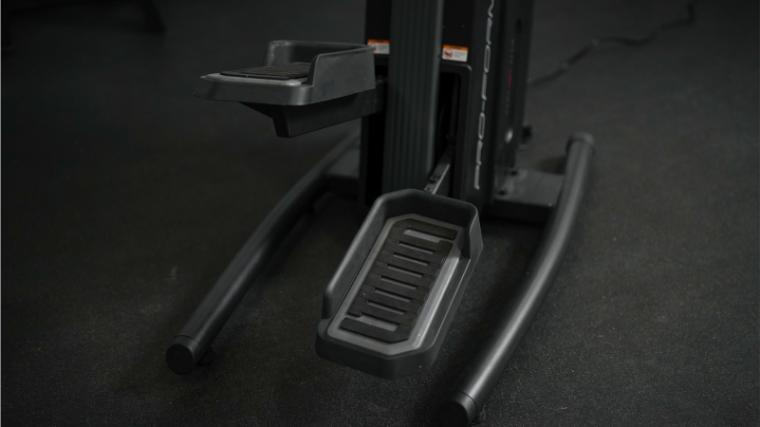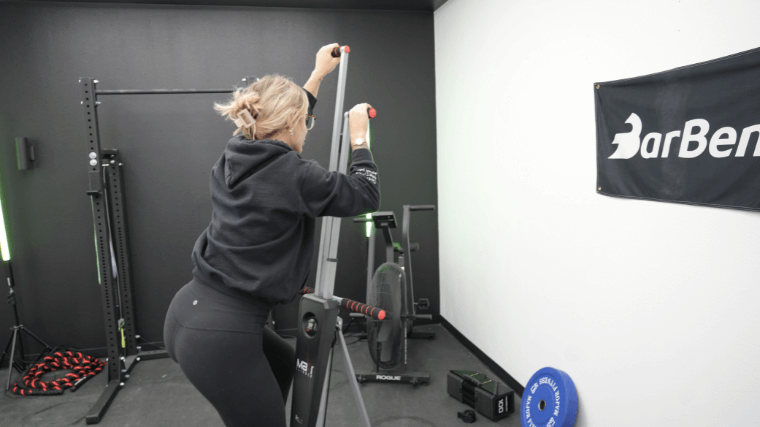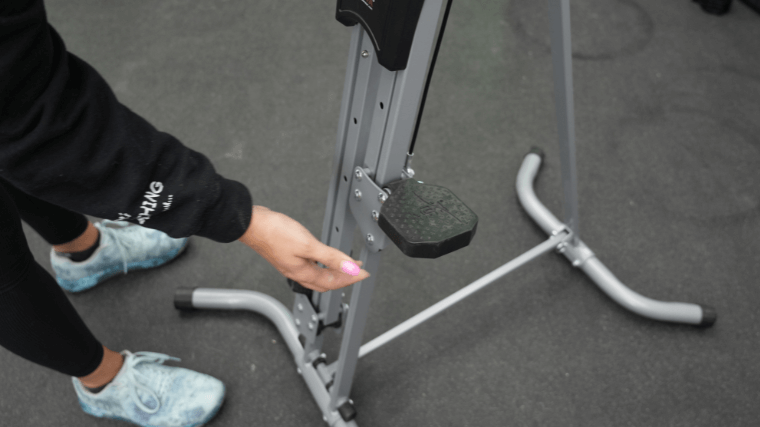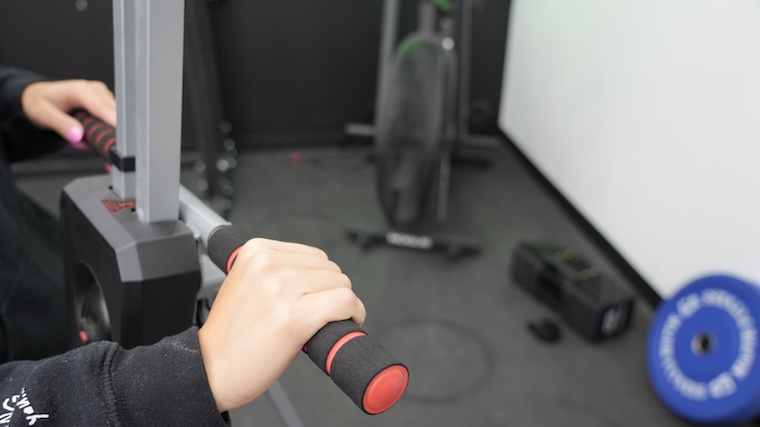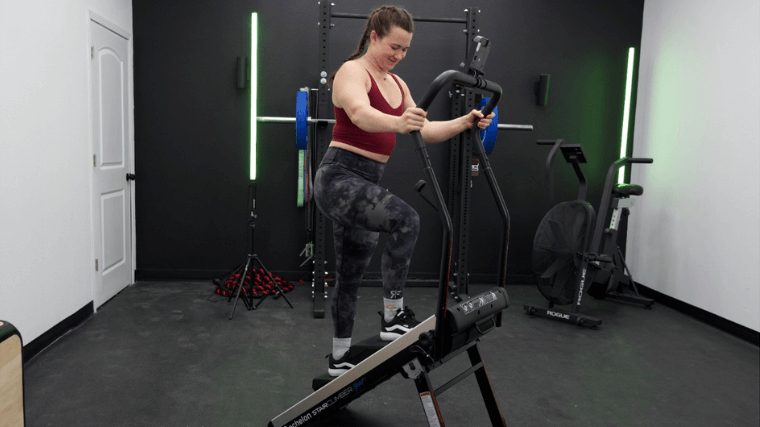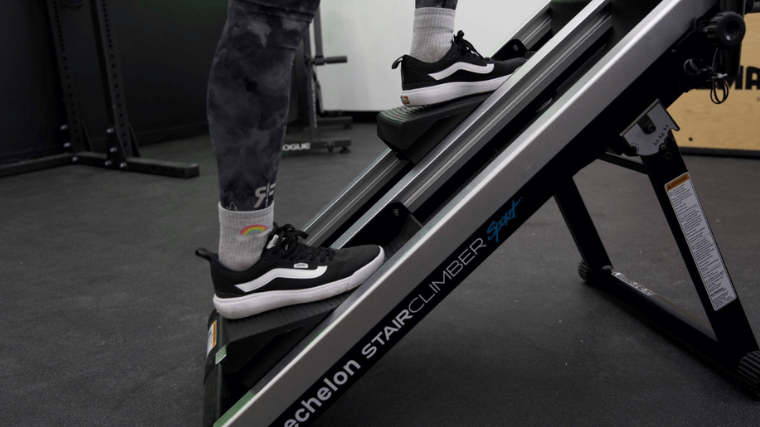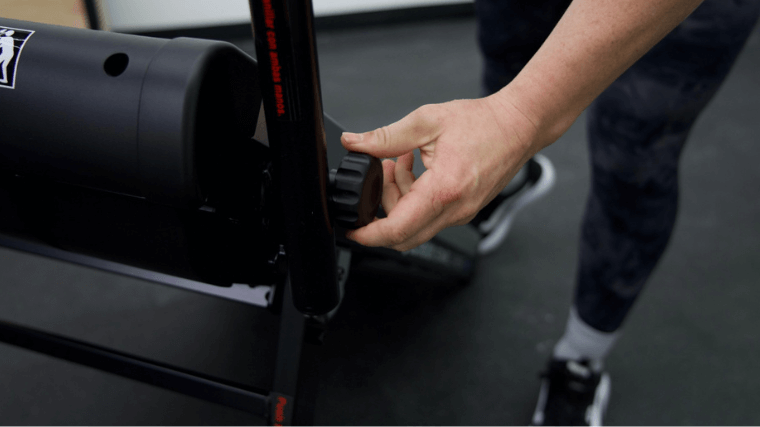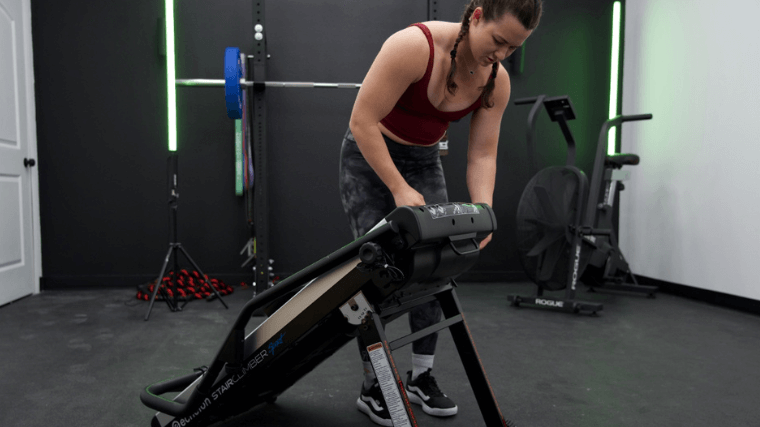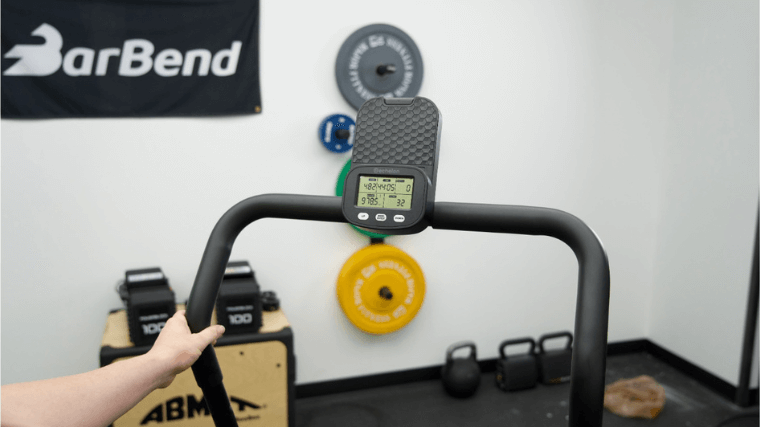Interested in adding one of the best cardio machines to your home gym but tight on space? Vertical climber machines have been shown to increase your caloric burn and maximal heart rate more than cardio machines like rowers or treadmills. (1)(2) The best vertical climbers also allow you to train intensely without sacrificing your entire floor plan.
Of course, there are a handful of factors to consider when considering a vertical climber exercise machine for your personal training paradise. We’ve climbed through the category and gotten hands-on with a number of top-performing silhouettes over the years. With this insight, as well as help from our team of in-house experts, we’ve curated this guide to our favorite vertical climbers available today.
The 6 Best Vertical Climbers of 2025
- Best Vertical Climber Overall: ProForm Pro HIIT H14
- Best Budget Vertical Climber: MaxiClimber Vertical Climber
- Best Vertical Climber with Resistance: CLMBR Connected 02
- Best Vertical Climber for Beginners: Echelon Stair Climber Sport
- Best Folding Vertical Climber: Relife Rebuild Your Life Vertical Climber
- Best Premium Vertical Climber: Rogue Versaclimber SM Magnetic
How We Tested and Chose the Best Vertical Climbers
The BarBend team is made up of competitive athletes, certified personal trainers, and lifelong fitness enthusiasts. To determine the best vertical climbers available today, we got hands-on with 14 different climbers from top brands across multiple cardio workouts, using a multi-point methodology to rate each profile on a scale of 1 (lowest) to 5 (highest) to determine our top picks. Below are some of the categories and components we looked at to come up with our findings.
For further information on how we trial and test the products chosen for this guide and more, be sure to read the BarBend Equipment Testing Methodology page.
- Equipment Footprint: Vertical climbers can be more compact than the best rowing machines and treadmills, but that doesn’t mean they’re right for every room arrangement. We looked closely at each chosen profile, specifically noting the height — we wanted to ensure these machines could fit comfortably in a standard 8-foot ceiling height. (3)
- Height and Weight Capacities: A vertical climber that can’t fit your body is basically useless, right? As such, we noted the maximum weight and height levels for each chosen machine and also looked for silhouettes featuring adjustable frames that could be fine-tuned to one’s personal height needs.
- Resistance Levels: Added resistance can be great for facilitating higher caloric burn and strength-building potential. (4) However, many vertical climbers offering adjustable resistance also come with higher price tags, so we made sure to include a handful of bodyweight-driven machines, as well.
- Portability: While some vertical climber machines require a dedicated space for operation, others can be more lightweight and optimal for small spaces when it comes to use and storage. We made sure to include both profiles in this round-up, as we know every athlete has their own unique floor plan.
- Value: Vertical climbers can definitely fall under some of the best compact exercise equipment, but that doesn’t mean their price should be indirectly related to their value. We sought out profiles that we felt matched their price tag best, whether that be through integrated fitness apps and durable steel frames or lightweight models that can be conveniently stored away when not in use.
Best Vertical Climber Overall: ProForm Pro HIIT H14

This unique profile combines a stair climber and elliptical for a space-saving, high-performance training experience. The Pro HIIT H14 is also integrated with the iFIT online workout program, giving you access to over 17,000 live and on-demand fitness classes.
Specs
- Price: $1,799
- Max User Height: Not listed
- Weight Capacity: 325lbs
- Resistance Levels: 26
- Product Dimensions: 52″ L x 29″ W x 66″ H
For those that want an excellent full-body workout experience with their vertical climbing machine, we recommend the Pro HIIT H14 from ProForm. This fitness machine is a hybrid of sorts combining the movements of a stepper and elliptical into one silhouette. Plus, the vertical orientation helps keep the footprint to just 10.47 square feet — less than the average 15.31-square-foot footprint of a standard loveseat. (6)
We’ve previously ranked the HIIT H14 as one of the best compact ellipticals, too, thanks to its durable frame and whisper-quiet operations. Our tester, a CrossFit Level 1 instructor, rated the durability at 5 out of 5, stating, “I really enjoy how stable this fitness machine is. There’s no jostling across the integrated touchscreen and you don’t feel as if you’re going to topple over mid-session. Plus, the 30-pound flywheel is above the industry standard for ellipticals, meaning it’s super quiet and not distracting at all.”
The HIIT H14 can also be a high-quality pick for those that prefer on-demand workout programs. ProForm equipment is compatible with the iFIT fitness app, which boasts over 17,000 on-demand classes across multiple fitness disciplines. We rated the available programming at 5 out of 5 given the versatility, too.
That said, you cannot stream other apps like Netflix or Hulu with this exercise equipment. The monitor is only compatible with iFIT, meaning you’ll need to set this machine near a television if you prefer to train as you catch up on your favorite series.
Lastly, the HIIT H14 can be a challenge to set up, according to our tester who rated the assembly process at 2 out of 5. “If you’re not particularly handy or don’t have the time, I’d highly recommend paying the extra cash for in-home professional assembly,” they add.
Read our full ProForm Pro HIIT H14 Review.
Best Budget Vertical Climber: MaxiClimber Vertical Climber
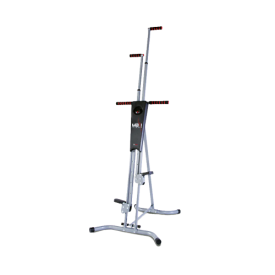
This simple, compact vertical climber can be a great budget-friendly option for full-body training. The MaxiClimber classic also folds up neatly to just 3.02 square feet, which can be ideal for storing your equipment in less spacious environments.
Specs
- Price: $179
- Max User Height: 6’2”
- Weight Capacity: 240lbs
- Resistance Levels: N/A
- Product Dimensions: 35.82” L x 28.3” W x 86.52” H
Vertical climbers can be expensive pieces of home gym equipment — we’ve found that the average price of high-quality vertical climbers equates to roughly $2,000. However, there are some budget-friendly models out there that can be ideal for home workouts, such as the MaxiClimber Vertical Climber. At roughly $180, it’s well below the average cost and still delivers in terms of low-impact, high-intensity performance.
Another reason we hold the MaxiClimber Vertical Climber in high regard is its compact footprint. It’s among the best budget home gym equipment we’ve tested, taking up 7.04 square feet of space during use and just 3.02 square feet when folded. This can be ideal for athletes training with limited floor space and the main reason why we scored the MaxiClimber’s footprint at 5 out of 5.
The MaxiClimber does not feature any adjustable resistance levels, meaning you’ll be working against your actual body weight during sessions. “I think this can be fine for most athletes,” says our tester, who rated their overall workout experience at 3 out of 5. “But those wanting an extra sense of challenge may be left wanting more.”
There is a small LCD monitor at the center of this vertical climber capable of tracking steps taken and calories burned. However, there are no preset workout programs to choose from. This makes sense, though, given that there’s no need for programming modules if you’re constantly working against the same resistance level.
While this MaxiClimber is definitely a simple, bare-bones machine, that does lend itself to easier portability and assembly. According to our tester, the machine arrives basically ready to use and you only need to attach a few pieces. We scored the assembly process at 5 out of 5 and feel it’s a great starting point for those looking to build their own home gym without the headaches other, more complicated machines can bring to the table.
Read our full MaxiClimber Vertical Climber Review.
Best Vertical Climber with Resistance: CLMBR Connected 02
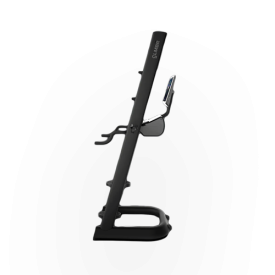
The CLMBR Connected 02 features adjustable handles for alternating grip positions, as well as a sturdy frame capable of holding up to 350 pounds. Additionally, there’s plenty of tech strewn across the profile, including an integrated app delivering on-demand classes, challenges, guides, and more.
Specs
- Price: $3,995
- Max User Height: 7’
- Weight Capacity: 350lbs
- Resistance Levels: 11
- Product Dimensions: 35” L x 32” W x 88” H
Training against resistance can be great for your workout routine, as studies show that resistance training can lead to reduced body fat, increased muscular strength, boosted cardio endurance, and more. (4) With 11 available resistance settings to choose from, the CLMBR Connected 02 is our favorite vertical climber for people wanting more strenuous, challenging workouts.
The CLMBR, one of best commercial stair climbers we’ve tested, can be excellent for those looking to up the ante when it comes to their daily ascents. The 21.5-inch HD touchscreen displays helpful information during your sessions, including average tempo, distance climbed, calories burned, and more.
We also enjoy the ergonomics of this high-end, well-built machine, rating the CLMBR at 4 out of 5 for the category. There are adjustable handles for neutral, overhand, and underhand grip positions during training. “I also like that you’re instructed to change your grip positioning prior to your chosen workout program,” adds our tester, a CrossFit Level 1 instructor. “It eliminates the need to pause your training in order to ensure your settings are adjusted accordingly.”
Speaking of, the CLMBR Connected 02 is also capable of streaming instructor-led fitness classes through the brand’s companion app. The 21.5-inch HD touchscreen provides a clear picture for following along mid-workout, and the app boasts a plethora of classes, challenges, and guides to keep every workout engaging and entertaining. As such, we rated the available programming at 5 out of 5.
While we applaud this workout machine for its versatility and in-workout feel, we scored the assembly at 2 out of 5 given the rather complicated instructions. According to our tester, the instruction manual is very difficult to follow, and the complicated alignments required for proper setup definitely require a helping hand or two. For this reason, we highly recommend opting for a premium delivery and installation, which the brand offers for $300.
Read our full CLMBR Connected 02 Review.
Best Vertical Climber for Beginners: Echelon Stair Climber Sport
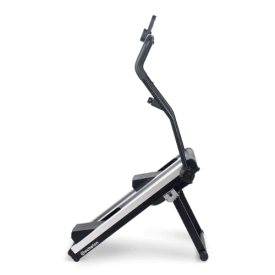
The Echelon Stair Climber Sport features adjustable resistance and three different incline settings for a wide range of workout setups. This portable stair climber also comes equipped with a convenient device holder for following along to your favorite on-demand workouts and streaming services on your own mobile device.
Specs
- Price: $799.99
- Max User Height: Not listed
- Weight Capacity: 275lbs
- Resistance Levels: Not listed
- Product Dimensions: 39” L x 22” W x 55” H
Just getting into vertical climbing? Looking to supplement your outdoor rock-climbing hobbies with a dedicated indoor machine? Consider the Echelon Stair Climber Sport. At roughly $800, it’s well below the average $2,000 cost of other vertical climbing machines while also being lightweight and portable enough for setups wherever you please.
Our tester, a certified personal trainer, rated the assembly process at 5 out of 5. “You won’t need more than 20-30 minutes for this Echelon profile since the fitness equipment comes put together to near entirety,” they say.
This Stair Climber Sport silhouette mimics the best stair climbers in that you’re focusing mainly on lower-body musculature in a given session. The front handrails do not rotate or move for upper-body engagement, so if you do desire a full-body experience, you may want to look elsewhere.
Speaking of the handlebars, our tester did note that you can experience a bit of jostling and wobbliness across the frame. “I did appreciate the grippy foot pedals, but I felt some shakiness across the hand rail at times, especially when I adjusted the machine to its highest incline setting,” they added. As such, we rated the durability at 2.5 out of 5.
The Echelon Stair Climber Sport features adjustable resistance that’s controllable by a turnstile knob. According to our tester, these adjustments can be somewhat difficult to make, particularly mid-session. “The knob isn’t the most ergonomic, and you do struggle to really dial in your preferred setting. I attribute this, mostly, to the cheaper design of the components,” they say.
While we scored our overall experience with the Echelon Stair Climber Sport at 3 out of 5, we still believe it’s a suitable product for those just getting into vertical climbing as a discipline. The machine is easy to set up, easy to store, and can be a great way to get your sweat on throughout the day.
Best Folding Vertical Climber: Relife Rebuild Your Life Vertical Climber
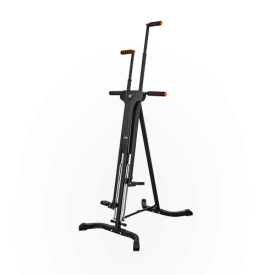
This compact vertical climber can fold up to a footprint measuring 3.13 square feet, which can be ideal for storage needs. Plus, the five available height adjustments can be excellent for creating a comfortable setup for athletes anywhere from 5’9” to 7’1”.
Specs
- Price: $399.99
- Max User Height: 7’1”
- Weight Capacity: 250lbs
- Resistance Levels: N/A
- Product Dimensions: 37.5” L x 28” W x 85” H
Vertical climbers can be great for athletes tight on space thanks to their smaller footprint than other cardio machines. That said, having a profile that can be stored easily when not in use can be helpful when trying to make the most of your training area. The Relife Rebuild Your Life Vertical Climber folds for easy storage, taking up just 3.13 square feet of flooring.
We rated this Relife vertical climber at 4.5 out of 5 for its footprint, too, given its lightweight yet sturdy frame capable of supporting user weights up to 250 pounds. “The A-frame design gives you a better sense of structure when training with this machine. You don’t feel like you’re wobbling or shaking all over the place,” says our tester.
The Relife Rebuild Your Life Vertical Climber is pretty basic in terms of technical features. We scored the profile at 2 out of 5 for tech given the rather mundane center display. The console is capable of tracking time, total steps, calories burned, and fat burned, but the size is almost too small to conveniently monitor progress. Plus, there is no media holder that would allow for DIY streaming setups — if you’d like to follow along to one of the best online workout programs, you’ll want to set it up in front of a television or monitor.
We also found that there are no “true” resistance levels across this machine, meaning you’ll be training against your actual body weight. That said, the brand does state that the adjustable heights can be used to toggle the intensity of your sessions. The setup can be adjusted to suit athletes from 5 feet 9 inches all the way up to 7 feet 1 inch. As such, we rated the adjustability at 4 out of 5.
Lastly, the foam handles can be comfortable enough for regular use, but our tester cautions that they can begin to lose their grip once sweat begins to roll. “I’d keep a towel handy to wipe off any perspiration,” they note. “It can go a long way in helping you preserve your grip during longer sessions.”
Best Premium Vertical Climber: Rogue Versaclimber SM Magnetic
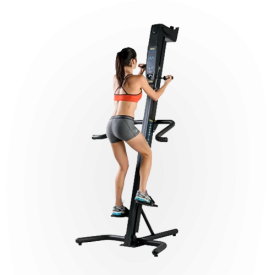
As one of the original climbing machines, this impressive rig can provide loads of training potential across its tension range that now includes 11 magnetic resistance levels. Additionally, there are 15 built-in modules designed to push your workouts to new heights … literally.
Specs
- Price: $5,695
- Max User Height: Not listed
- Weight Capacity: 350lbs
- Resistance Levels: 11
- Product Dimensions: 46″ L x 43″ W x 94” H
For advanced athletes wanting the best of the best, this foundational vertical climber can be the perfect fit. Versaclimbers are some of the original climbing machines, and this SM Magnetic model, available through Rogue Fitness, comes equipped with plenty of features to help you get the most out of your daily ascents.
[Related: Rogue Discount Code]
“While the price definitely lends itself to more of a commercial setting, I feel this Versaclimber can be an excellent addition to any premium home gym,” says our tester, who rated the value at 3.75 out of 5. “The durability is top-notch, and I appreciate that you have the option for floor-mounted, wall-mounted, or freestanding profiles.”
We scored the durability at 5 out of 5, given that, regardless of your design, you still receive the same steel frame capable of supporting user weights up to 350 pounds. However, we will note that floor-mounted and freestanding options will add $500 to the already-expensive $5,695 price tag.
The SM-Magnetic also features a magnetic resistance system with 11 toggleable settings. This integration pairs nicely to the premium belt and eddy-current brake system also used across the build, giving you plenty of challenge as you pace through workouts.
This vertical climber’s center console is also of note thanks to its Bluetooth connectivity and seamless syncing with the Versaclimber app. While on-machine toggles are still utilitarian — there is no touchscreen — we rated the tech at 4 out of 5 given your ability to monitor and analyze your key metrics through your favorite smart device. There are also 15 included workout programs — six racing modules and nine distance-centric sessions.
As a final note, this is one of the tallest vertical climbing machines we’ve tested. Measuring 94 inches tall, it can be best to break out a tape measure prior to purchase to ensure this machine can fit comfortably in your abode.
Benefits of Vertical Climbers
Vertical climbers can be beneficial for athletes wanting to perform the best cardiovascular exercises. Outside of their unique vertical plane of motion, these machines can be ideal for facilitating calorie-burning, total-body training sessions. Below are a handful of perks that can come with adding a vertical climber to your workout space.
- Low-Impact Training: Studies show that low-impact training can be an effective form of physical activity with lower odds of injury. (5) Vertical climbers can be excellent options for athletes desiring a training regimen of this nature, as you’re not putting your joints, feet, and frame through a ton of strain in a given stride.
- Higher Caloric Burn: Certified personal trainer Alex Polish, our expert reviewer, states, “Even when you’re moving slowly, your whole body is involved, and it’s bound to boost your heart rate quite a bit.” According to Harvard Health, rock climbing — essentially the same motion plane you’re working in atop a vertical climber — can be an efficient physical discipline capable of high caloric burn, depending on your weight. (2)
- Compact Design: Vertical climbers are also more compact pieces of equipment than other cardio machines, such as the best ellipticals, treadmills, or rowing machines. This is due to the vertical plane of motion that sees you move your body upward rather than horizontally in a given rep.
How Much Do Vertical Climbers Cost?
Vertical climbing machines can range in cost greatly depending on their included features, weight ratings, and other factors. On average, though, we’ve found that roughly $2,145 can net you a high-quality machine worthy of its place within your home gym. Naturally, there are cheaper and more expensive options on the market, so read below to compare the prices of the best vertical climbers included in this guide.
| Best Vertical Climber Overall | ProForm Pro HIIT H14 | $1,799 |
| Best Budget Vertical Climber | MaxiClimber Vertical Climber | $179 |
| Best Vertical Climber with Resistance: CLMBR Connected 02 | CLMBR Connected 02 | $3,995 |
| Best Vertical Climber for Beginners | Echelon Stair Climber Sport | $799.99 |
| Best Folding Vertical Climber | Relife Rebuild Your Life Vertical Climber | $399.99 |
| Best Premium Vertical Climber | Rogue Versaclimber SM Magnetic | $5,695 |
What to Consider Before Buying Vertical Climbers
According to BarBend expert reviewer Alex Polish, a certified personal trainer, “The cardio machine you choose will, generally speaking, be a matter of matching your goals and needs to your machine.” As such, while vertical climbers can be effective, space-saving options for some, they may not be ideal for your specific fitness goals and home workout setup. Below are some factors worth considering when thinking about adding a vertical climbing machine to your home gym.
Equipment Footprint
Thanks to their compact designs, vertical climbers can be beneficial for athletes with small workout spaces. Since you’re moving in a vertical plane rather than a horizontal one, you don’t need a lengthy track or belt to facilitate a worthwhile motion during training. Still, though, you want to ensure your machine fits your available space. Take some measurements prior to purchase to ensure your new machine doesn’t crowd your area with an excessive footprint.
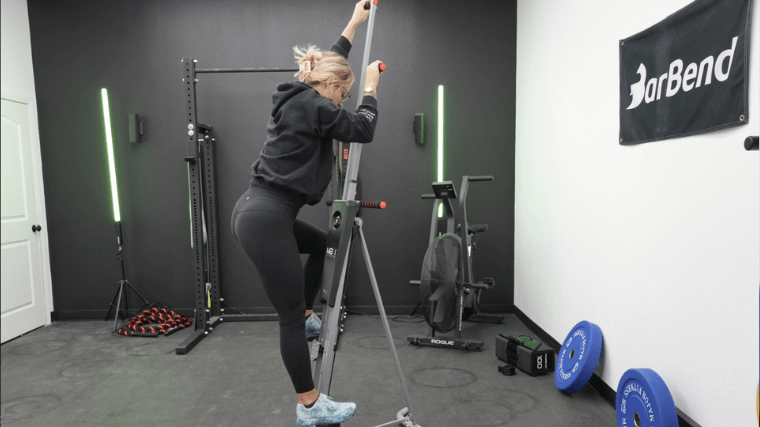
You’ll also want to make sure you have the proper clearance for your machine, so be sure to flip your tape measure upward during pre-purchase measurements. Typically, athletes with 8-foot ceilings should have enough overhead space to accommodate a vertical climber, but it doesn’t hurt to double-check.
Height and Weight Capacities
You’ll be putting your entire body weight across your vertical climber, so finding a profile that’s capable of supporting your frame during training is a must. “You don’t want anything feeling rickety, so take a look at the brand reputation, materials used, and reviews to make sure everything will be stable,” adds Polish.
Take a glance at the vertical climber’s weight capacity and compare it to your given weight. Ideally, you should have some space between the two metrics, as this can help alleviate any potential strain or unnecessary stress across your machine. Typically, vertical climbers can support anywhere from 240 to 350 pounds.
[Related: Best Treadmills for Heavy People]
You should also consider your vertical climber’s height capacity prior to purchase. After all, the motion calls for you to stretch your physique to its tallest capabilities, and having a confined setup could lead to discomfort and compromised form. If you are a taller athlete, it may be wise to opt for a vertical climber with available arm extensions. This can help extend the step range while also keeping the motion comfortable across your larger physique.
Features
When searching for your top vertical climber, be sure to think about your desired conveniences, too. Some climbing machines are capable of streaming some of the best fitness apps, while others simply come equipped with a standard LCD display for monitoring time, calories burned, and steps taken. Other features worth looking at include the handle designs, any available water bottle holders or extra storage compartments, Bluetooth connectivity, and more.
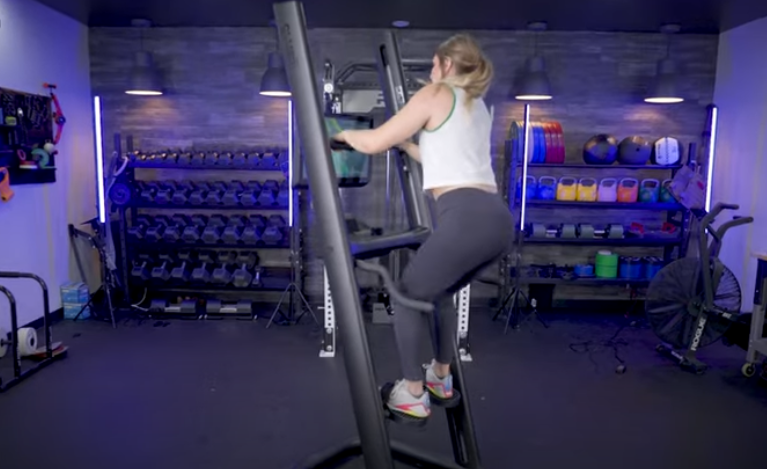
Foldability can also be a noteworthy feature to look for, especially if you’re trying to train in more confined spaces. These lightweight vertical climbers feature hinges in key areas to help shrink their footprint for easier storage. Be mindful, though, that foldable vertical climbers typically feature lower weight capacities — the lightweight materials cannot support the same loads as those with more durable yet less portable build components.
Resistance Levels
Having a vertical climber with a resistance system can be a nice benefit, especially if you’re trying to utilize the machine for strength-training workouts. That said, we’ve had plenty of worthwhile ascents that work against our body weight alone, so the feature isn’t absolutely needed for quality training. Be sure to take your fitness level and desired goals into consideration when deciding how much resistance you require in a vertical climber.
It should be noted, too, that vertical climbers without integrated resistance levels can often be cheaper than their challenge-ready counterparts. If you’re looking to save a little money on your home gym equipment, this can be a worthwhile tidbit to have on your mind.
Price
Like any piece of fitness equipment — from the best exercise bikes to stair climbers, weight benches, and beyond — you’ll want to ensure your machine fits within your budget before building out your vertical climbing workout plan. These profiles built for indoor ascents can range from a few hundred dollars to $5,000 and beyond, so there is a wide range of options. Additionally, some vertical climbers are integrated with online workout programs that will require an additional subscription, likely between $25 and $40 monthly.
Always be sure that your budget can support your training goals before adding any vertical climber to your cart. Yes, the benefits can help you take your training to new heights, but it’s much more difficult to crawl out of debt than it is to climb through a workout session.
Vertical Climber FAQs
Can you build muscle with a vertical climber?
Yes, vertical climbers can help you build muscle within your training. If you want to primarily use this machine as a strength-training tool, it may be best to look for a profile featuring multiple resistance levels. Training against resistance has been shown to help support muscle growth along with reduced body fat, improved functional capacity, and other perks. (4)
What is the best vertical climber?
Determining the “best” vertical climbing machine can be subjective. In our opinion, the Pro HIIT H14 from ProForm is the best of the bunch thanks to its elliptical-stepper hybrid motion plane and its array of available resistance levels. The machine is also compatible with iFIT, which gives you access to over 17,000 on-demand workout classes for better engagement with your training.
Are vertical climbers hard on your knees?
While any physical activity has the potential to cause joint discomfort, training with a vertical climber can lessen the impact felt across your knees more so than other disciplines. You aren’t lifting your legs off the ground in a given rep, and your body is constantly in contact with the machine itself. This can help facilitate a workout setup that less taxing on your joints, which can lead to fewer injuries and instances of discomfort. (5)
What is the weight limit for a vertical climber?
The weight capacity of a vertical climber can vary from brand to brand. The profiles included in this round-up range in limits from 240 to 350 pounds. When deciding on a vertical climber for your training regimen, make sure your machine’s weight capacity aligns with your body weight.
How much do vertical climbers cost?
On average, you can expect to pay roughly $2,000 for a high-quality vertical climber. Naturally, cheaper and more expensive options exist within the category, so be sure to think through your budget and opt for the silhouette that fits your needs and finances best.
References
- BRAHLER, C. J., & BLANK, S. E. (1995). Versaclimbing elicits higher VO2max than does treadmill running or rowing ergometry. Medicine & Science in Sports & Exercise, 27(2).
- Calories burned in 30 minutes of leisure and routine activities. Harvard Health. (2021, March 8). https://www.health.harvard.edu/diet-and-weight-loss/calories-burned-in-30-minutes-for-people-of-three-different-weights
- Rybczynski, W. (n.d.). Ceiling Heights in Homes and Offices. Ceiling Heights in homes and offices – Zell/Lurie Real Estate Center. https://realestate.wharton.upenn.edu/working-papers/ceiling-heights-in-homes-and-offices/
- Kraemer, W. J., Ratamess, N. A., & French, D. N. (2002, June). Resistance training for Health and Performance. Current sports medicine reports. https://pubmed.ncbi.nlm.nih.gov/12831709/
- Tse, A. C., Wong, T. W., & Lee, P. H. (2015). Effect of low-intensity exercise on physical and cognitive health in older adults: A systematic review. Sports Medicine – Open, 1(1).
- Jaramillo, C. (2022, December 29). A guide to sofa dimensions & sizes. SeatUp, LLC. https://seatup.com/blog/guide-to-sofa-dimensions/
